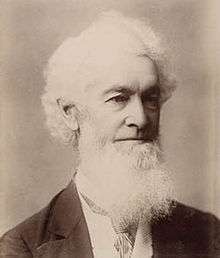John Hay (New South Wales politician)
Sir John Hay KCMG (23 June 1816 – 20 January 1892) was a New South Wales politician.
John Hay | |
|---|---|
 | |
| Born | 23 June 1816 Little Ythsie |
| Died | 20 January 1892 (aged 75) |
| Nationality | Australian |
| Known for | politician |
Life
Hay was born at Little Ythsie, Aberdeenshire, Scotland, the son of John Hay (a farmer) and his wife Jean, née Mair. Hay graduated M.A. at King's College (now part of the University of Aberdeen), in 1834, and then studied law at Edinburgh, but did not finish it. In 1838 Hay married Mary Chalmers and they travelled to Sydney on the Amelia Thompson, arriving on 1 July and settled at Welaregang on the Upper Murray. Hay migrated to Sydney in 1838 and took up land in the Murrumbidgee district and became a successful squatter.[1][2]
Hay was a strong opponent of tariffs on trade between New South Wales and Victoria and was elected in April 1856 as the member for Murrumbidgee in the first Legislative Assembly and took up residence in Sydney. In September, he moved a vote of no-confidence in the Cowper ministry, which brought the government down. Hay recommended to governor William Denison that Henry W. Parker should be asked to form a coalition ministry in which Hay was secretary for lands and works. This ministry was defeated in September 1857 and Hay did not again hold office. In 1859, he was elected as a member of the new seat of Murray and strongly opposed John Robertson's land bills and sought to protect the interests of squatters. In the December 1860 elections, fought on the issue, he was one a few opponents of Robertson elected.[1][2][3]
In June 1860, Hay moved that negotiations should be opened up with Victoria for the purpose of establishing a uniformity of customs duties. This would have been a valuable step towards a federation system, but his motion was defeated. On 14 October 1862, Hay was unanimously elected speaker of the Legislative Assembly and carried out his duties impartially. In 1864, Hay successfully contested the seat Central Cumberland, near Sydney to make clear his opposition to the making of the Riverina into a separate colony. In October 1865, finding his health had been affected, he resigned as speaker. In June 1867 he was nominated a member of the Legislative Council and in July 1873 was appointed its president on the recommendation of Sir Henry Parkes. He held this position until his death in the Sydney suburb of Rose Bay, survived by his wife for ten days. They had no children.[1][2][3]
Hay was not a party man but he had knowledge and wisdom, and though he originated little he was a good speaker and debater who had no little influence on the legislation of his time. Hay carried out his duties as speaker of the assembly and president of the council with great ability.[1]
References
- Serle, Percival (1949). "Hay, Sir John (1816 - 1892)". Dictionary of Australian Biography. Sydney: Angus and Robertson. Retrieved 5 February 2009.
- Martin, A W (1972). "Hay, Sir John (1816 - 1892)". Australian Dictionary of Biography. Melbourne University Press. ISSN 1833-7538. Retrieved 30 October 2019 – via National Centre of Biography, Australian National University.
- "Sir John Hay (1816-1892)". Former Members of the Parliament of New South Wales. Retrieved 13 May 2019.
External links
- Mennell, Philip (1892). . The Dictionary of Australasian Biography. London: Hutchinson & Co – via Wikisource.
- Carlyle, Edward Irving (1901). . Dictionary of National Biography (1st supplement). London: Smith, Elder & Co.
| New South Wales Legislative Assembly | ||
|---|---|---|
| Preceded by New seat |
Member for Murrumbidgee 1856 – 1859 Served alongside: Macleay |
Succeeded by William Macleay |
| Preceded by New seat |
Member for Murray 1859 – 1864 |
Succeeded by Robert Landale |
| Preceded by John Laycock |
Member for Central Cumberland 1864 – 1867 Served alongside: Macpherson |
Succeeded by John Lackey |